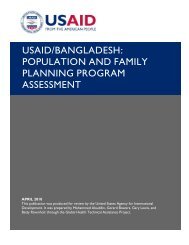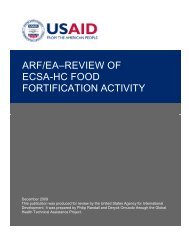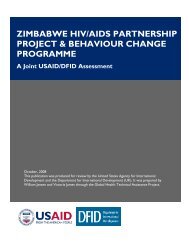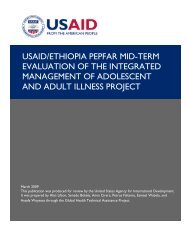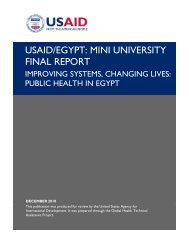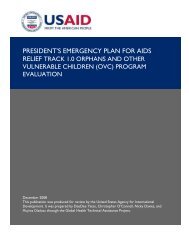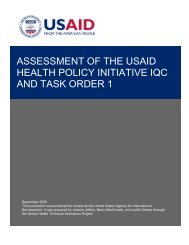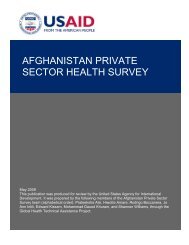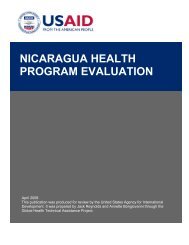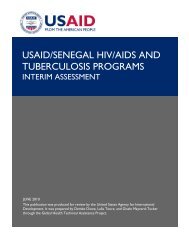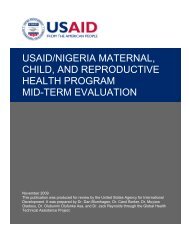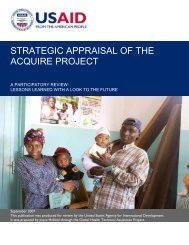Food utilization practices, beliefs and taboos in Nepal: An overview
Food utilization practices, beliefs and taboos in Nepal: An overview
Food utilization practices, beliefs and taboos in Nepal: An overview
- No tags were found...
Create successful ePaper yourself
Turn your PDF publications into a flip-book with our unique Google optimized e-Paper software.
Magars, observed that though both communities kept buffaloes, Brahmans used them only fortheir secondary products whereas Magars ate their meat as well. Magars, who did not raise pigsbecause they considered them messy, did <strong>in</strong> fact consume pork.<strong>An</strong>other example taken from the hills is presented by Gallagher, 7 who reported about the life <strong>in</strong> aGurung village <strong>in</strong> Gorkha district <strong>in</strong> 1987. This report described the food <strong>and</strong> agricultural<strong>practices</strong> <strong>in</strong> that community. The report may not be considered a description applicable to all theGurungs <strong>in</strong> <strong>Nepal</strong>, yet it gives a good <strong>in</strong>sight <strong>in</strong>to the food <strong>practices</strong> <strong>in</strong> a particular Hillcommunity. Gallagher writes:―On ris<strong>in</strong>g, the villagers eat a snack of roasted pulses <strong>and</strong> or popped corn. They thendepart to gather the first grass of the day for the animals. The women return <strong>in</strong> time tocook the morn<strong>in</strong>g rice meal, which will be eaten any time between 9-11 a.m. The usualgra<strong>in</strong> eaten is corn although millet is widely eaten. Both gra<strong>in</strong>s are ground on the stonegr<strong>in</strong>dstone <strong>and</strong> made <strong>in</strong>to coarse flour which is then cooked up to a thick porridge. Thisflour can also be made <strong>in</strong>to breads. Although the rice is the gra<strong>in</strong> of preference it is noteaten daily by the majority of people. The prote<strong>in</strong> source is usually black gram or soyabeans cooked with spices. If a vegetable is available, this will also be eaten with the gra<strong>in</strong><strong>and</strong> or green leafy vegetables. If this is not available, the villagers may just eat the ma<strong>in</strong>gra<strong>in</strong> flavoured with turmeric along with a prote<strong>in</strong> source. The majority of people dr<strong>in</strong>keither water, homemade beer or their own distilled alcohol. A considerable amount of themillet grown <strong>and</strong> a certa<strong>in</strong> amount of the corn is used by the villagers not as a food, butto make this beer or alcohol. The concentrated beer can be eaten thick as a snack, oftenthis is the way older children eat it or water can be added to make a thick soup like dr<strong>in</strong>k.The analysis of the concentrated beer showed rather a higher alcohol content than hadbeen expected <strong>and</strong> as this beer is given to children, this could have serious implications.”These few examples show that there is a diverse set of food consumption patterns depend<strong>in</strong>g onthe region, caste, <strong>and</strong> food availability. Furthermore, the use of available products is also veryimportant to underst<strong>and</strong> <strong>and</strong> could be potentially harmful to a child, for example millet <strong>and</strong> cornbasedalcohol <strong>in</strong> the Hills. Therefore, programs aimed at improv<strong>in</strong>g the nutritional status ofwomen <strong>and</strong> children will have to consider these diverse consumption patterns <strong>in</strong> order to <strong>in</strong>formrecommendations on diets depend<strong>in</strong>g on the place <strong>and</strong> population.CALORIC INTAKE OF THE POPULATIONA significant proportion of the <strong>Nepal</strong>ese population consume less than adequate calories asreported by CBS on the basis of National Life St<strong>and</strong>ard Survey (NLSS) 2003-2004 <strong>and</strong> SmallArea Estimation of Poverty. 8 The prevalence of <strong>in</strong>adequate caloric <strong>in</strong>take varies from 35.2% to39.8% of the adult population <strong>in</strong> <strong>Nepal</strong>. The calorie requirement was estimated at 2709 Kcals/dayrequired susta<strong>in</strong><strong>in</strong>g moderate activity. The estimates were calculated on the basis of reportedexpenditure on food. The prevalence of <strong>in</strong>adequate caloric <strong>in</strong>take levels is highest for the regionswith the lowest food production: Midwestern <strong>and</strong> Far Western regions have a prevalence of<strong>in</strong>adequate caloric <strong>in</strong>take higher by 7% to 8% compared to the national averages.There is no relationship between food availability <strong>and</strong> calorie <strong>in</strong>take <strong>in</strong> urban areas: availability ishigher than <strong>in</strong> many rural areas, yet the prevalence of <strong>in</strong>adequate caloric <strong>in</strong>take was found to bethe highest for urban Kathm<strong>and</strong>u. This could be due to the methodology used, which calculates7 Gallagher, C. M. <strong>An</strong> <strong>overview</strong> of life <strong>in</strong> a Gurung Village <strong>in</strong> Gorkha district. 1987.8 GoN/NPC/CBS/WFP. Small Area Estimation of Poverty, Caloric Intake <strong>and</strong> Malnutrition <strong>in</strong> <strong>Nepal</strong>.Kathm<strong>and</strong>u, <strong>Nepal</strong>, 2006.FOOD UTILIZATION PRACTICES, BELIEFS AND TABOOS IN NEPAL: AN OVERVIEW 7




